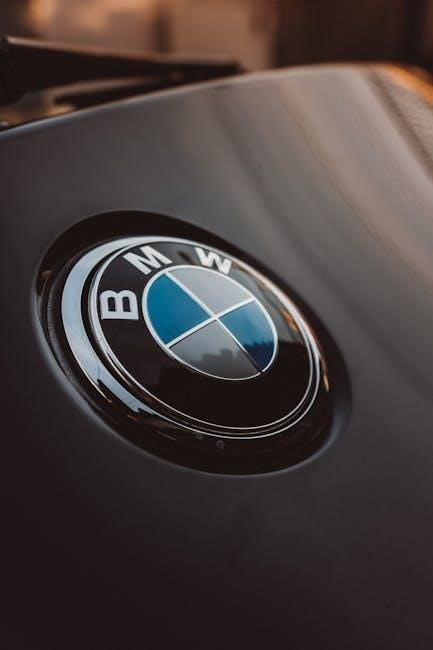BMW X5 Buyer’s Guide

Embarking on the journey of purchasing a BMW X5 requires careful consideration․ This guide helps navigate the complexities of choosing the right model․ We explore different generations‚ reliability ratings‚ potential issues‚ and pricing to equip buyers with knowledge․ It helps make informed decisions before investing in this luxury SUV․
Generations of the BMW X5 (E53‚ E70‚ F15‚ G05)
The BMW X5 has seen four distinct generations‚ each with its own characteristics․ The first‚ the E53 (1999-2006)‚ marked BMW’s entry into the SUV market․ It had a striking design and muscular aesthetics; Next‚ the E70 (2007-2013) offered enhanced features and addressed some initial concerns․
The F15 (2014-2018) brought updated technology and design elements‚ including the X5M variant․ The current generation‚ G05 (2019-present)‚ features advanced driver assistance systems and hybrid powertrains․ Each generation offers a unique driving experience and set of features․
The E53 provided a blend of luxury and utility‚ establishing the X5’s reputation․ The E70 refined the formula with improved performance and comfort․ The F15 introduced modern technology and styling updates․ The G05 continues to innovate with hybrid options and advanced safety features․
Understanding these generations helps buyers to appreciate the evolution of the X5․ The differences in design‚ technology‚ and reliability contribute to the overall ownership experience․ Exploring each generation allows consumers to find the X5 that meets specific needs and preferences․ It also helps in assessing value in the used car market․

BMW X5 Reliability Ratings and Scores
When evaluating a BMW X5‚ reliability ratings and scores are very important․ These metrics provide insights into the vehicle’s dependability based on owner experiences․ Sources like J․D․ Power and RepairPal offer reliability scores․ They help potential buyers gauge the likelihood of encountering issues․
The BMW X5 Reliability Rating is 2․0 out of 5․0․ This ranks it 13th out of 19 for luxury fullsize SUVs․ The average annual repair cost is $1‚166․ This suggests it has poor ownership costs․
Consumer Reports also provides reliability data based on owner surveys․ These ratings consider various factors‚ including engine reliability‚ transmission performance‚ and electrical system functionality․ Models from 2018 have received mixed reviews‚ with some owners reporting problems․
It is important to consider that reliability can vary by model year․ Newer models often benefit from design improvements and updated technology․ But older models may have a track record of known issues․ Examining these ratings‚ buyers can identify years with higher or lower reliability․ It is important to make informed decisions․
It’s always a good idea to research specific model years․ You can also consider owner forums and reviews to get a comprehensive understanding․ This can provide valuable insights into potential problems and overall satisfaction․
Common BMW X5 Problems and Issues

Several common problems and issues have been reported by BMW X5 owners․ Understanding these potential pitfalls helps buyers make informed decisions․ One frequent issue is water leakage‚ which can damage the interior․ This can also lead to costly repairs․
Another common problem involves the cooling system‚ particularly water pump failure․ This can cause overheating․ It can also cause engine damage if not addressed promptly․ Oil leaks are also a common concern‚ especially in older models․ These leaks can stem from various sources․ Examples are valve cover gaskets and oil pan seals․
Electronic failures also affect various components‚ such as tailgate mechanisms and camera systems․ Other reported issues include creaky tailgates‚ malfunctioning rear-view cameras‚ and problems with child safety locks․ Transmission failures are also common‚ and can result in costly repairs․
Some models with the N57 diesel engine have experienced timing chain issues‚ requiring extensive repairs․ Owners have also noted problems with vibrations during turns‚ potentially related to the transmission or transfer case․
Addressing these common issues through proactive maintenance is key to preserving the X5s longevity․ Regular inspections and timely repairs can minimize problems and ensure reliability․ Remember to research specific model years for their most common faults․ This will provide a comprehensive understanding of potential issues․
BMW X5 Model Years to Avoid (2008-2009‚ 2012-2014)
Certain BMW X5 model years have demonstrated more frequent and severe problems․ Therefore‚ buyers should exercise extra caution when considering these years․ Specifically‚ the 2008 and 2009 model years are known for various issues․ These include water leakage‚ coolant pump failures‚ and electrical problems․ Owners have reported significant water intrusion into the vehicle’s interior‚ leading to costly repairs․
The 2012 to 2014 model years also exhibit notable reliability concerns; These models have shown a higher incidence of engine issues and transmission problems․ Many owners have reported that the sudden engine stops and no cranking happen often․ These issues are often unfixable‚ which makes maintenance and restoration difficult․
The 2008 X5 also ranks high for transmission and brake problems․ The 2009 BMW X5 may suffer from AC/heat trouble‚ while the 2010 X5 is known for fuel system issues․ Steering clear of these model years will help minimize potential headaches and costly repairs․
Before purchasing‚ thoroughly inspect any X5 from these years․ A pre-purchase inspection by a trusted mechanic is highly recommended․ This will help identify any existing or potential problems․ Checking the vehicle’s maintenance history and any recall information is also essential․ This helps buyers make a more informed decision․
Used BMW X5 Pricing and Considerations
The used BMW X5 market presents a wide range of options․ Prices vary greatly depending on the model year‚ mileage‚ condition‚ and features․ Older X5 models‚ those 15 years or older‚ may be available for under $5‚000․ However‚ these vehicles may raise reliability concerns due to their age․
For a more dependable used X5‚ consider newer models․ A typical 2018 BMW X5 has an average asking price of around $33‚953․ This reflects a premium due to current inventory challenges․ Prices are subject to change․
When evaluating a used X5‚ consider several factors․ Maintenance history is crucial․ Look for vehicles with complete and consistent service records․ This indicates that the previous owner took care of the vehicle․ Have a trusted mechanic perform a pre-purchase inspection․ This will identify any potential issues․
Also‚ consider the specific features and options․ Some X5 models have advanced technology and luxury features that may increase their value․ Check for any recalls or service bulletins․ These can reveal potential problems and any necessary repairs․ Buying a used car can provide peace of mind․
Specific Engine Issues (N57 Timing Chain‚ N55‚ B58)
Certain BMW X5 engines are known for specific issues that potential buyers should be aware of․ The N57 diesel engine‚ used in X5 models from 2006 to 2012‚ has a known weakness related to its timing chain․ The timing chain can stretch over time․ It can eventually break‚ leading to significant engine damage․ Replacement is expensive because the chain located on the engine’s rear․
The N55 engine‚ used in X5 models from 2011 to 2013‚ is an updated version of the N54․ It may experience similar problems․ The B58 engine‚ found in later X5 models‚ has demonstrated improved reliability but is not immune to issues․
When considering an X5 with one of these engines‚ research the engine’s maintenance history․ Look for evidence of timing chain service or preventative maintenance․ Regular oil changes and proper maintenance can help mitigate some of these risks․ A pre-purchase inspection by a qualified mechanic is essential․ This is important to assess the engine’s overall condition․
Maintenance and Repair Costs
Owning a BMW X5 brings a certain level of prestige‚ but it’s crucial to consider the maintenance and repair costs․ These costs can be higher than those of non-luxury SUVs․ The average annual repair cost for a BMW X5 is around $1‚166‚ indicating potentially high ownership expenses․
Common issues like water leaks‚ water pump failure‚ and transmission problems can lead to significant repair bills․ Models with the N57 engine may face costly timing chain repairs․ The valve cover and oil pan replacements on G05 models with the B58 engine can also contribute to higher maintenance costs․
Proactive maintenance‚ such as regular oil changes‚ can help minimize problems․ Using a BMW specialist for servicing can provide expertise and potentially reduce costs․ Consider extended warranties for older models to protect against unexpected major repairs․ Factor in the cost of premium parts and specialized labor when budgeting for X5 ownership․ A comprehensive understanding of these expenses is vital for informed ownership․
2021 BMW X5 Features and Potential Problems
The 2021 BMW X5 stands out as a luxury midsize SUV‚ equipped with strong engines and advanced technology․ Its features include advanced driver assistance systems and spacious‚ tech-filled interior․ This model offers a comfortable driving experience with soft leather seats‚ heating‚ and ventilating options․ The traffic jam assist mode is a highly desirable feature․
However‚ potential reliability issues should be considered․ Some units of this model year have faced common problems․ Prospective buyers should be aware of potential issues related to electronics and various components․ Examining warranty coverage for possible repairs is advisable․
Despite its modern features‚ the 2021 X5 continues to be plagued by reliability issues in some units․ Thoroughly inspect the vehicle’s history and consider a pre-purchase inspection by a qualified mechanic․ Understanding potential problems ensures a more informed decision when purchasing a 2021 BMW X5․

2025 BMW X5 Reliability Prediction
Predicting the reliability of the 2025 BMW X5 involves analyzing data from previous model years․ Based on trends from the 2022‚ 2023‚ and 2024 models‚ current expectations suggest above-average reliability for the 2025 X5․
The prediction also considers the BMW brand’s overall reliability score․ However‚ it’s crucial to remember that these are just predictions‚ and real-world reliability can vary․ Potential buyers should monitor owner reviews and expert evaluations as they become available․
For the 2025 X5 Plug-in Hybrid‚ reliability is expected to be about average when compared to the average new car․ This prediction is based on data from 2022‚ 2023‚ and 2024 models and the BMW brand score․
While early indications are promising‚ it’s essential to stay informed․ Factors like new technologies‚ design changes‚ and production processes can affect reliability․ Keeping abreast of updates will provide a more accurate assessment closer to and after its release․